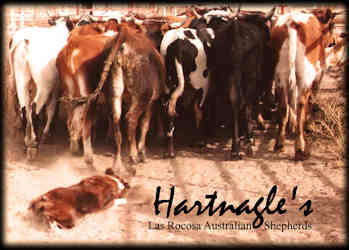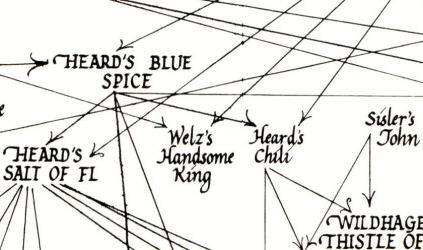 |
||
|
Education: Books, Videos & Herding Clinics
|
The Spider Web
Many have asked, “What is the Spider Web?” The Spider Web is an original chart of Australian Shepherd genealogy. It depicts clear lines of relationship between the different families of dogs following a timeline along the development of the breed and the geographical areas where they were developed.
The chart was created by Ernest Hartnagle then calligraphed by Mike Ryan. The Spider Web represents a high level of historical knowledge and was ten years in the making.
It was designed to illustrate a visual ancestral pictorial of the influential contributing sires and dams. Chronologically, the Spider Web encompasses a forty year period starting at the top with dogs that were living during the 1940s and descending in ten year increments to the 1980s when the intermingling of families began. Up until that time there were four major families of dogs contributing to the majority of Australian Shepherds, Juanita Ely’s bloodline, Fletcher Wood’s dogs, Dr. Heard’s Flintridge line and Hartnagle’s Las Rocosa Aussies. It also includes the old Arizona dogs, early California lines and the dominant bloodlines from the Pacific Northwest.
The key dogs, those few that had a major impact through their offspring appear in larger letters. The dogs that appear in smaller letters are link dogs. These dogs are those individuals that were genetic carriers passing on their traits to later offspring who went on to continue the family heritage.
Some of the dogs had limited breeding opportunities, but still managed to stamp their influence on the breed. Some Aussies did quite a bit of winning for a period of time, and whose influence lasted only a generation or so. Still yet there were others who were considered good producers and even now are considered important in modern pedigrees.
The object of the design was to be simple enough to hold the viewers attention without exhausting his or her concentration, yet detailed enough to be of historical and educational value.
Near the beginning, in the early 1960s when Aussies were first registered, ancestral information was obtained by word of mouth, and old letters. Many dogs in the early pedigrees were not registered.
Under the old National Stock Dog registry system, each time that a dog changed ownership, the previous owner’s name was deleted and the new owner’s name entered as the prefix to the dog’s name. The aggregate result being that an individual dog could possibly have two or more owners in its lifetime and subsequently lose its identity to all except those who personally knew the dog.
My father relied heavily on personal experience with the dogs, early breeders, ranchers and the owners of the dogs. For instance, Green’s Kim, Nettesheim’s Twinkles, and Smedra’s Mistingo to name a few, lived only a few miles from the family farm and ranch in Boulder Colorado. We knew them well.
Others, such as the Brezeale dogs from Modesto California were dogs that Juanita Ely personally knew or even bred. Most of Jeneane Harper’s original dogs were dogs she purchased from Juanita. A point of interest, Mrs. Ely was my mother, Elaine Hartnagle’s godmother.
As mentioned earlier, there were no sources where people could research pedigrees and study the close relationship of bloodlines through the development of the breed. In the early registry, and consequently in some of the pedigree books slight discrepancies have occurred, however in the overall scheme of things they are of minimal significance.
ASCA started registering kennel names in the 1970s. The criteria we used for selecting our kennel name required a unique, descriptive moniker that we hoped later on would become an identifying symbol for a distinct bloodline that our family members could also use. The Las Rocosa name came about because it was distinctive and explanatory of our location at the base of Las Montanias Rocosas (Rocky Mountains). The last requirement, to become an identifying symbol, has been realized with the passage of time. Names were selected for a wide variety of reasons. Marcia Hall chose the Fieldmaster Kennel name after their foundation sire, Ch. Fieldmaster of Flintridge. The Coppertone name was chosen because the Klines hoped to perpetuate the brilliant copper trim in their bloodlines since it was not so common in the breed at that time.
~~ Jeanne Joy Hartnagle-Taylor
Return to the Stewardship and Education page
|
|
